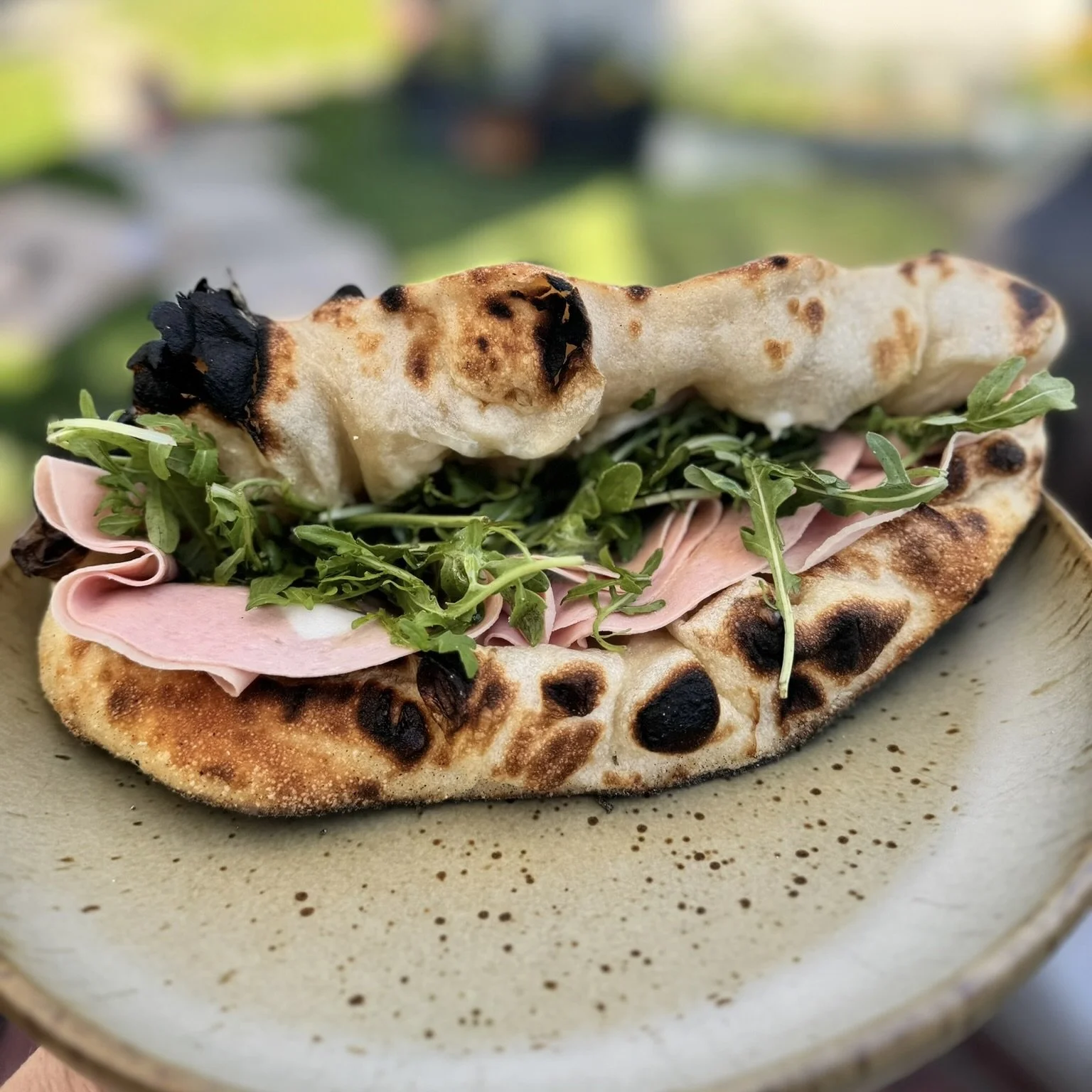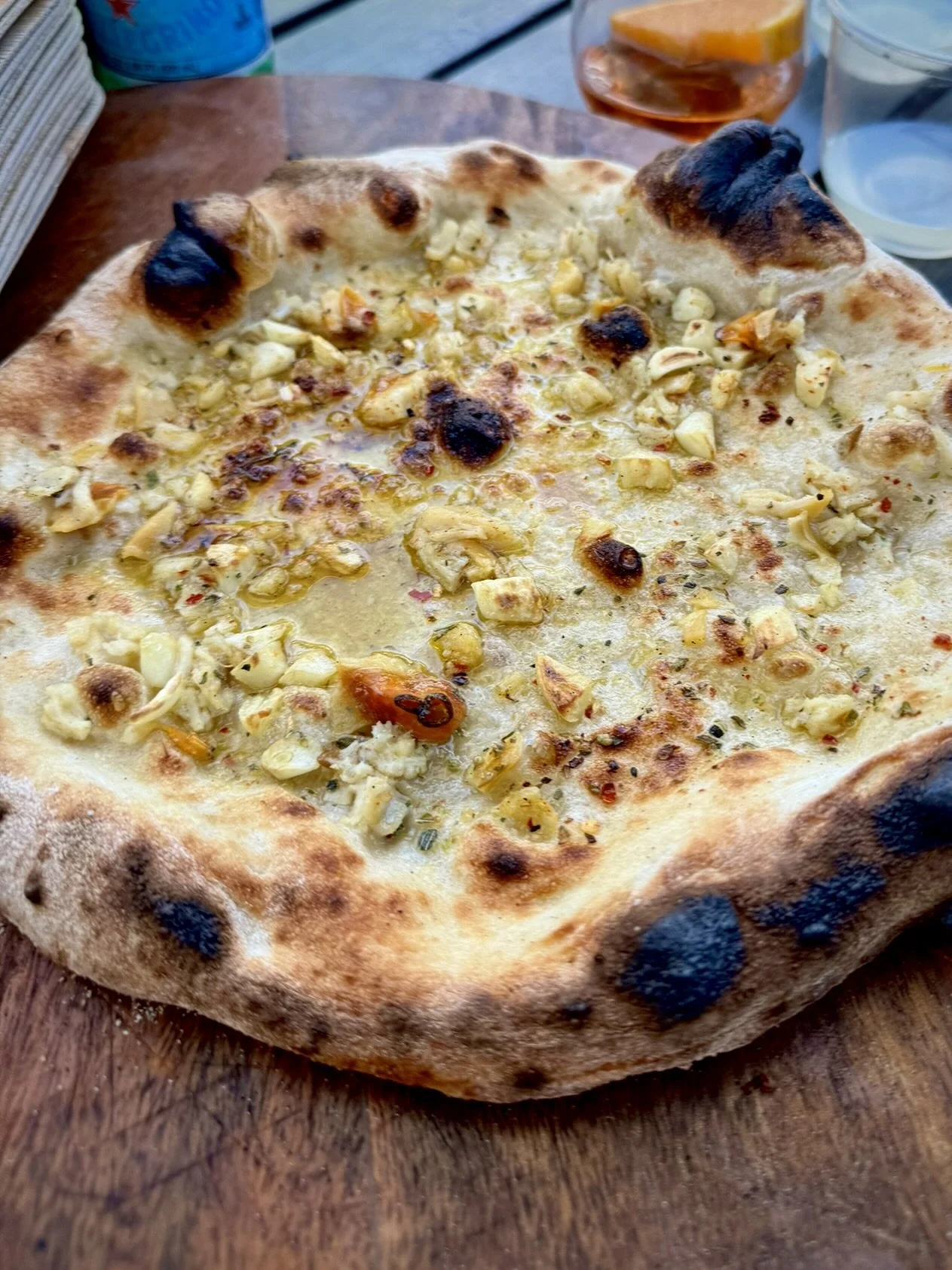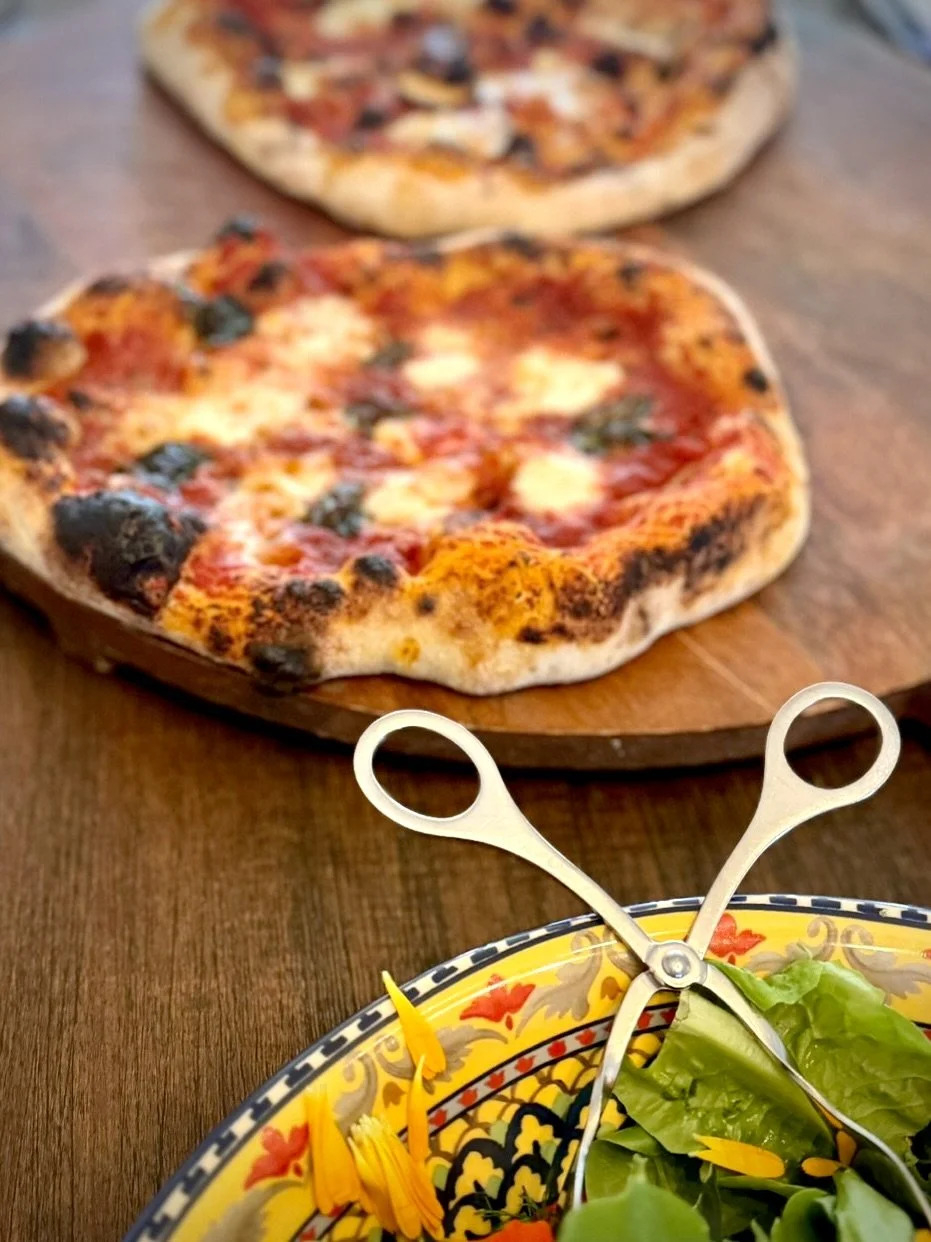Contemporary Neapolitan: Blasphemy or Brilliant?
Is it sacrilege or science? Tradition or transformation? Let’s dig into the dough.
The Contemporary Neapolitan cut with GOLD scissors. Certo!
Our Journey from Blasphemy to Belief
Years ago, we found ourselves in Naples, following the flour-dusted footsteps of the Caputo family—yes, that Caputo. Maruro Caputo led us to Vincenzo Capuano’s pizzeria, where we watched dough magic happen: the signature biga method, stretched and shaped before our eyes.
The crown—the cornicione—stood tall, like a blistered halo. Crisp on the outside, pillowy on the inside. Fermented aroma, sweet caramelization. Since then, we haven’t looked back.
We’ve shared this recipe with friends, tweaked it in our home kitchen, and used it for everything from classic pies to Panuozzo—our favorite Neapolitan "sandwich shell." Imagine: blistered and airy, split open like a pita, filled with mortadella, truffle, burrata, and arugula. Pure revelation.
Caputo: The Flour Behind the Movement
Founded in 1924, Mulino Caputo is the most revered flour mill in Naples and one of the most recognized names in pizza worldwide. Known for consistency, quality, and performance, Caputo produces flours that honor tradition while enabling innovation.
Caputo Rosso 00: Ideal for long fermentation and high hydration, perfect for contemporary Neapolitan and biga-based doughs. High protein (~13.5%) and excellent gluten structure.
Caputo Nuvola: Engineered for airy, high-oven-spring pizza with a light, open crumb. Often used in modern interpretations of Neapolitan and gourmet pizza.
Caputo sponsors global pizza competitions, including the prestigious Trofeo Caputo in Naples, considered the "World Cup of Pizza."
Neapolitan Pizza by the Numbers
2,000+ pizzerias in Naples, and 20,000+ worldwide serve Neapolitan-style pizza
1,000+ AVPN-certified pizzerias across 50+ countries
Added to the UNESCO Intangible Cultural Heritage list in 2017
Official dough: only four ingredients – flour, water, salt, yeast
Baked at 430–480°C (800–900°F) for 60–90 seconds
Over 5 billion pizzas consumed globally per year
Panuozzo: A Neapolitan Street Food Gem
Invented in Gragnano in the 1980s, Panuozzo is made from pizza dough baked into a loaf, then split and stuffed with mozzarella, prosciutto, or roasted vegetables. The result? The best sandwich you’ve ever had.
To make one at home, start by stretching your pizza dough into a 12-inch round. Drizzle a ring of olive oil around the outer edge, then gently fold the dough in half into a half-moon shape—do not press the edges together. Bake it in a pizza oven until puffed, blistered, and golden.
It’s one of the best ways to use up extra pizza dough. You can even bake and freeze them for later—just reheat in the oven and stuff with your favorite fillings for a sandwich on the fly.
At our house, Panuozzo is the appetizer or first course of pizza night. It’s our test bake to see if the dough is ready—or if it needs a bit more time. And it gives our guests a snack before the pizza feast begins.
Mortadella, Truffle Relish, Buratta, and Arugula Panuozzo…This is BOMB!
The Dough Debate: Traditional vs. Cold Fermentation vs. Biga
Here’s a technical breakdown of the three main approaches to Neapolitan dough, with pros, cons, and ideal use cases:
Traditional Neapolitan
Pros: Classic flavor, AVPN certified, soft and pillowy.
Cons: Requires intuition and active timing, less flexible for busy schedules.
Best for: Purists, tradition-driven pizzaiolos.
Cold Fermentation
Pros: Tangy complexity, beginner-friendly, high scheduling flexibility.
Cons: Slightly denser texture, not AVPN certified.
Best for: Restaurants needing prep flexibility, home bakers with busy lives.
Contemporary (Biga Method)
Pros: Airy, crispy-blistered crust, sweet and nutty flavor, dramatic oven spring.
Cons: Advanced skill required, not AVPN certified, precise hydration control needed.
Best for: Modern artisans, showcase pies, anyone chasing pizza transcendence.
Traditional, Cold, or Biga?
Is it sacrilege or science? Tradition or transformation? Let's dig into the dough.
| Criteria | Traditional Neapolitan | Cold Fermentation | Contemporary (Biga) |
|---|---|---|---|
| Fermentation Temp | Room temp only (~18–24°C / 64–75°F) | Cold retard (~4°C / 39°F) | Biga at ~20°C / 68°F, final dough proof at room temp |
| Mix to Oven | 12–24 hrs total | 24–72 hrs in fridge + rest | 12–16 hrs biga + 4–6 hrs final dough |
| pH Range | 5.2–5.5 (final dough) | 5.2–5.5 (final dough) | Biga: 4.8–5.0, Final dough: 5.2–5.4 |
| Flavor Profile | Clean, light acidity | Deeper, tangy complexity | Balanced: sweet, slightly nutty, rich |
| Texture | Soft, pillowy, tender | Slightly denser, chewy | Airy, crispy-blistered crust, open crumb |
| Recommended Caputo Flour | Caputo Rosso 00 | Caputo Rosso 00 | Caputo Nuvola |
| Skill Level | Medium – intuitive feel needed | Beginner-friendly but needs planning | Advanced – requires timing & hydration control |
| Scheduling Flexibility | Low – needs active timing | High – good for service prep | Medium – flexible but precise |
| Authenticity (AVPN) | ✅ Certified method | ❌ Not certified | ❌ Not certified |
| Visual Appeal | Classic, slight crown | Golden, modest cornicione | High crown, dramatic oven spring |
| Use Cases | Tradition-driven pizzaiolos | Restaurants needing flexibility | Modern artisan & showcase pies |
Socials: @EatSundaySupper
Hello, World!
Pro Tips & Troubleshooting
Don’t over-handle your dough—gentle stretching preserves the airy crumb
Use a pizza stone or steel for maximum oven spring
If your dough feels tight, let it rest longer

Contemporary Neapolitan Pizza Dough
Ingredients
- Biga
-
13.25 oz Flour, Nuvola Super, Caputo
-
6 oz Water, Cool
-
1/4tsp Yeast, SAF Instant
- Final Dough
-
30.75 oz Flour, Nuvola Super, Caputo
-
24.5 oz Water, Cool
-
1.25 oz Salt, Kosher
-
19 oz Biga
Instructions
- Mix the Biga
- Place all the indredients in the mixing bowl and mix with a dough hook for 5 min on low speed. We are just trying to mix as well as we can. This will not form a smooth homogenous dough.
- Let ferment for 12 to 16 hours at around 60°-70°F or until a pH of 4.8-5.0
- Mix the Final Dough
- Place all the flour in a bowl with the water and mix for 4 min on low speed. Let it rest after mixing for 30 min, this is called Autolyse (Resting flour and water for gluten development.)
- Using a bench scraper, break up the biga into pieces and add to the dough and add to the mixing bowl
- Mix on first speed for 4 min.
- Change the mixer to the second speed and mix for 8 min or until fully developed and windowpane.
- Place the finished dough on a lightly oiled surface and apply a stretch and fold.
- Bulk ferment in a cool dry space in an oiled bin for 1 hour.
- Portion into dough balls into 240g pieces.
- Place in lighly oiled covered pizza proffing bins and allow to proof in a cool dry area for 4-6 hours.
- When dough is proofed and easily shaped bake in a hot pizza oven.
Notes
• 🔥 Oven floor temp: 790–860 °F
• 🌡️ Dome temp: 895–930 °F
• ⏱️ Bake time: 70–90 seconds
* If you are baking in a home oven. Set it to 500°F and bake on the back of a sheet pan or a pizza stone
• In a home oven at a lower temperature, the baking time will be 3-5 minutes.
• Go light on the toppings. The dough is the STAR, not the topings.
Family Touch: John’s Rating
We put each dough to the test in our kitchen. John’s verdict? Thumbs up for biga, sideways for cold fermentation, and a classic thumbs up for tradition. The real winner: whichever one brings everyone to the table.
Conclusion: Tradition Meets Technique
So—is Contemporary Neapolitan pizza a blasphemy? Or is it a brilliant evolution?
Maybe it’s both.
But when done right, it’s unforgettable.
Ready to try making Panuozzo or experiment with the biga method at home? Share your results with us—tag @EatSundaySupper and let us know if you’re a Traditionalist or a Modernist.
And don’t forget to subscribe for monthly recipes, family stories, and a taste of Italy delivered to your inbox.





